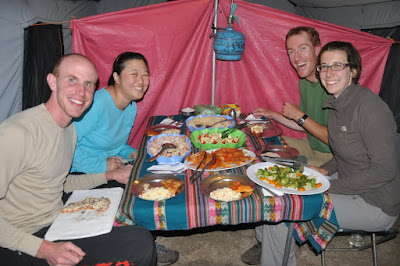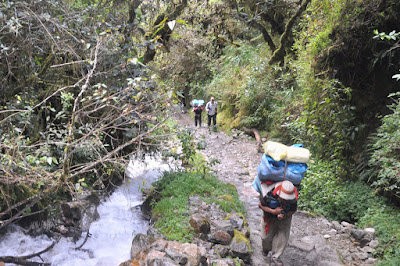A confession: I nearly deleted this entire post. It has frustrated me to write it. I had such anticipation for the Inca Trail, and I loved all of it. I was excited to be doing something so iconic, satisfied to capably accomplish something that I feared I might struggle with, and invigorated by spending four days walking in fresh Fall air among some of the most beautiful terrain I have seen. I was antsy at the start, waiting to take the first step at Km 82, and giddy at 4:30am on day 4, waiting in the rain to enter the last stretch. And I was dead tired at the end of it all. Beyond that, there is of course more story, but I feel the details don’t do justice to my experience, which competes for top spot on this trip, and near the top of all my traveling. That said, I spent a lot of time writing this, so please read on…
On the evening April 6, after our sojourn on Easter Island, we landed in Lima, Peru. On the morning of the 7th, we were back at the airport for our quick flight to Cusco, a town at 3,360m (11,000 ft). Due to the altitude, a few days stay in Cusco is pretty much the prerequisite to any Inca Trail hike – here you learn whether or not your body can function with slightly less oxygen than it may normally be accustomed to. Fortunately, we suffered only minorly with headaches and light-headedness, so we were good to go!
We were also lucky that our hotel was inviting enough to spend many hours doing a lot of nothing, as we planned on doing a whole lot of nothing during our couple days in Cusco. That said, we were pleasantly surprised by Cusco – it was definitely a tourist-centered town but it didn’t feel overbearing in that way. We weren’t hounded by hawkers, and we managed to find good, cheap, local food with relative ease.
 |
| Courtyard at Hotel Niños |
 |
| Plaza de Armas, Cusco |
OK on to the good stuff. Hiking the Inca Trail was one of our most-anticipated parts of this trip, and I was SO anxious to get it started! After much research we signed up with a company called Wayki Trek, which we chose for a few reasons: they keep their groups small (maximum 8 people); they have a reputation treating their porters well; and, of course, we found them to be “price reasonable”. One bonus of trekking with Wayki is you can sign up for an optional free night’s homestay in the porters’ village, and see what life is like for the Quechuan people in the mountains of Peru. Of course we signed up for this, and so we started our expedition a day in advance, traveling with our excellent guide Edwin up to the village of Huayllacocha, from which the company hires its porters. It also happened to be Edwin’s home village, although like many of his generation (he’s 29), he has permanently swapped village life for city life.
 |
| Quechua village nestled in the Andes |
 |
| An unfortunate mishap |
During our homestay we didn’t stay in the family house as in Laos (rather we slept in a tent, and had use of a drop toilet outhouse next to which the family’s donkeys were tethered for the night), but we did have our supper with them and spend the evening in the company of the family and some of the porters. This included dining on dried corn porridge (corn is ubiquitous in Peruvian cuisine, as it grows abundantly – not to mention freakishly large!), as well as dancing with a porter and the head porter's wife to some folk music… all while guinea pigs scurried underfoot. The kitchen was crawling with them – the family keeps them for food, and there were so many that when Edwin told us the fresh cheese with breakfast was guinea pig cheese, we believed him (for a second).
 |
| Thankfully the steps were quite simple |
 |
Corn so big you picked off the individual kernels to eat it
(photo courtesy of Phi, one of our fellow hikers) |
 |
Getting fattened up!
(This photo also courtesy of Phi, as somehow we didn't get any pix of the corn or the pigs!) |
In the morning, we were met by our hiking partners Matt & Phi, and started our trek in a non-traditional way – with Peruvian presidential elections! There were 12 candidates, with 5 in serious contention. A simple majority is needed to win, so this election wouldn’t even be the deciding one; there would be a run-off in June between the top 2 vote-getters. But in Peru, voting is mandatory, and so before we could start our hike our porters & guide needed to vote. If they didn’t, the government would fine them (debit their bank accounts) by $160, which is of course more substantial than it looks on paper when you put it in Peru terms. We finally hit the trail around 2pm, rather than the typical 10 or 11am start.
 |
| Villagers walk several miles to the nearest large town (Huarocondo) to cast their ballots |
 |
| Quechuans Queueing |
 |
| And... we're off! As soon as we finish taking these pictures... |
We were on the classic Inca Trail hike of 4 days / 3 nights, which took us up, over, and down 45km (28mi) of dirt and stone. Each day except the last started with a steep uphill climb – and on the first day we both though, uh oh, this is going to be more challenging than we thought. But we found our rhythm and while the walk was challenging, we are proud that we can say we didn’t really struggle with it. Even the infamous day 2 - the morning of which ascends about 1200m (over 3,900 ft), crosses “Dead Woman’s Pass” at the highest point on the trail at 4125m (13,829 ft), and descends to camp for another couple hours – we found not easy, but not too bad either. Actually, I found all the steps down on Day 3 the biggest challenge, and was glad to have rented hiking poles (which are now on my Christmas list). [Note “Dead Woman’s Pass” is not named for an unfortunate hiker; rather someone decided the hills that flank the pass rather looked like a woman on her back…]
 |
| Short break! |
 |
| Jason looks back on our progress |
 |
| At the peak of Warmiwañusca, aka Dead Woman's Pass |
Each evening we had ‘happy hour’ of popcorn, crackers & jam, and hot chocolate, and then dinner which was surprisingly good given the conditions. Our porter team carried all the supplies (including food, stove, tents, etc.) along the trail, each guy carrying about 20kg (44 lbs). Somehow they do this with speed that allows them to have everything set up by the time we arrive – you should see these guys move, especially on the downhill, uneven stony paths.
 |
| Our most scenic campsite, night 2 at Pacamayo |
 |
| Dig in! |
 |
| Our porter team |
 |
| Look at the load these guys carry! |
Of course one of the reasons for hiking the trail – other than the incredible scenery – is to see the Incan ruins. Edwin (our guide) was extremely knowledgeable and passionate about the Incan history, and gave us a good briefing of each of the many sites we came upon. Phi was badly affected by the altitude and needed to move slowly, so often Jason & I would go ahead while Edwin stayed with the other pair. This meant much of the time we were hiking on our own – in the sense we were not with our group, and miraculously not around many other people, either. This actually made for a very unique Trail experience, as most people are shepherded along in a group of 12-16 or so. At any rate, we were able to make a detour to see Winaywayna, one of the most remarkable of all the ruins. Unfortunately we didn’t have Edwin’s insights, but we did have the place to ourselves.
 |
| Edwin & Jason, chatting about the Incas |
 |
| Incredible location of Winaywayna |
 |
| The impressive remains of Winaywayna |
 |
| Looking a little matted at the end of Day 3 |
On the whole, we were lucky with the weather, with only a few drizzles here and there. On the last morning – a 3:30am wake-up to head to the Sun Gate, followed by arrival at our ultimate destination, Machu Picchu, we were greeted with a steady rain. We stood in this for an hour as we waited for the trail to open, and it slowly cleared up as we hiked. When we arrived at the Sun Gate, this was our view:
 |
| Not so sunny |
We waited for it to clear a little, then headed to the trail’s end, where we were treated to this view:
 |
| What?! This is not what it looked like in the guidebooks! |
All the same, it was incredible to have come this far. Edwin gave us a thorough and spirited tour of the ruins, but to be honest we were pretty beat and just wanted to sit down. Eventually we had our chance, and we marveled at the beauty of the location, how any ancient people could have found this spot, chosen it to build on, have done so with such skill (yet somehow they left no art behind?). The weather cleared and we walked back up to ensure we got the most ‘important’ picture of the trip:
 |
| See? We're really there! |
 |
| OK, this one may be more 'traditional' |
We left Machu Picchu completely exhausted yet wholly satisfied.
The rest of our stay in Peru was marred by a delayed train back to Cusco, a jam explosion in my backpack, a city water restriction after said jam explosion, and a lukewarm drip of a shower (after not having had one for 5 days) after a restless 4 hours of sleep. We also spent a transit day in Lima, which from what I can remember was enjoyable, although I was quite sleepy. I do remember a couple locals kindly advising us not to go further down a particular street, for our own safety – the rest I pretty much remember because we have some pictures. And eventually, we left it all behind on a 1:30am flight to Uruguay.











































